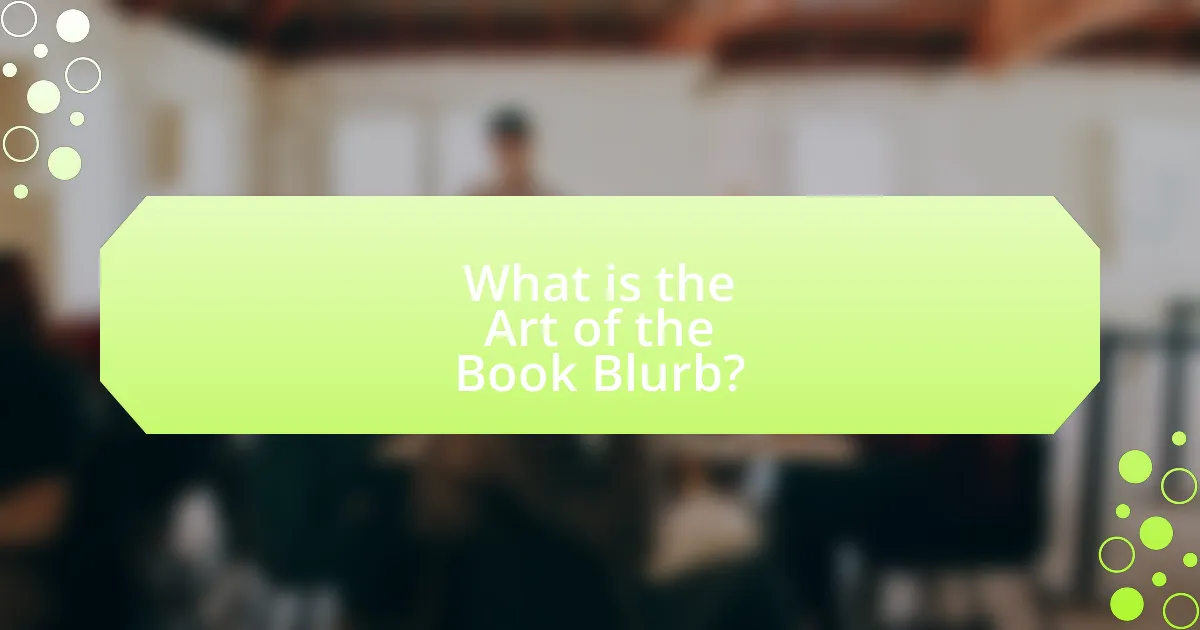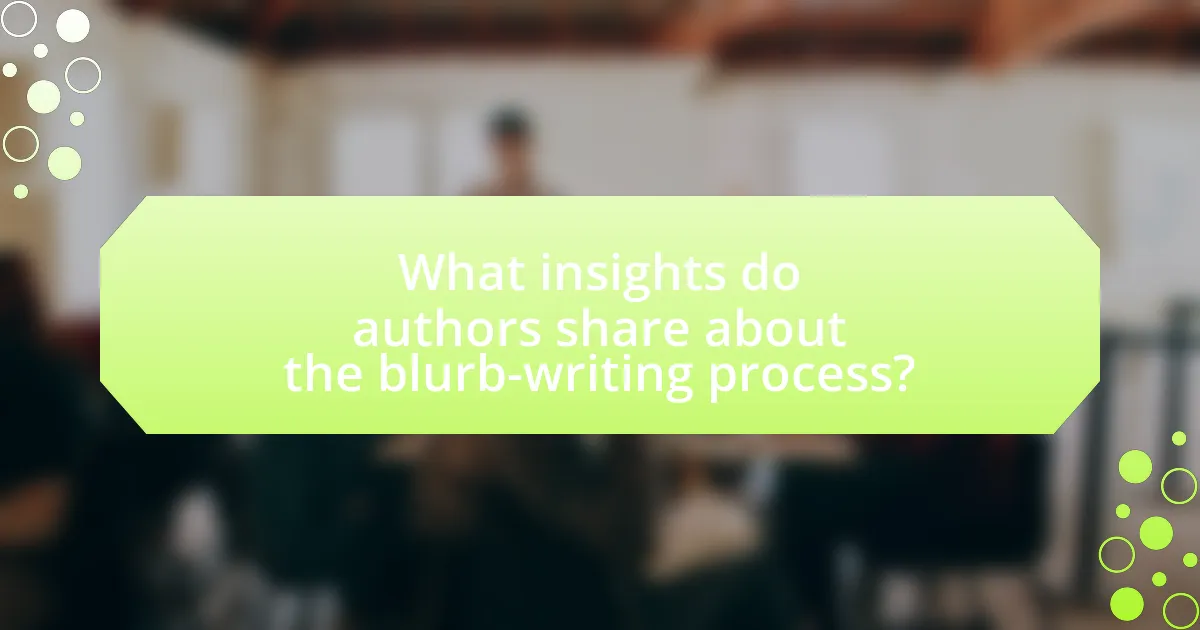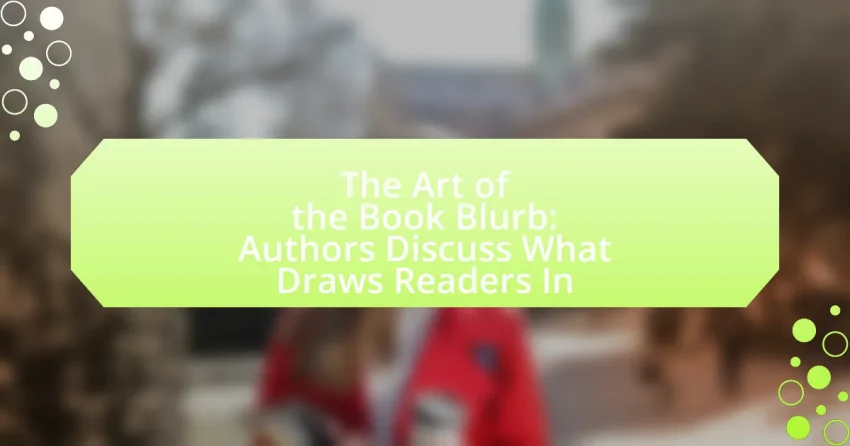The article focuses on the art of crafting effective book blurbs, emphasizing their critical role in attracting potential readers and influencing purchasing decisions. It outlines key elements that make a blurb successful, such as compelling hooks, concise summaries, and emotional engagement. Additionally, the article discusses strategies authors can employ to create captivating blurbs, the importance of aligning with genre expectations, and best practices for revision and refinement. Insights from authors highlight common challenges in blurb writing and the resources available for improving these skills, ultimately underscoring the significance of a well-crafted blurb in the competitive publishing landscape.

What is the Art of the Book Blurb?
The art of the book blurb is the skillful crafting of a concise summary that entices potential readers to engage with a book. A well-written blurb captures the essence of the story, highlights key themes, and presents compelling characters, all while maintaining brevity. Research indicates that effective blurbs can significantly influence purchasing decisions, with studies showing that 70% of readers decide to buy a book based on its blurb alone. This demonstrates the importance of mastering this art to attract and retain reader interest.
How does a book blurb influence reader engagement?
A book blurb significantly influences reader engagement by providing a concise summary that captures the essence of the story and entices potential readers. This brief description serves as a marketing tool, highlighting key themes, characters, and conflicts, which can evoke curiosity and emotional responses. Research indicates that 70% of readers decide whether to purchase a book based on its blurb, demonstrating its critical role in attracting interest and driving sales. By effectively communicating the book’s unique selling points, a well-crafted blurb can enhance reader engagement and increase the likelihood of a purchase.
What key elements make a book blurb effective?
An effective book blurb includes a compelling hook, a concise summary of the plot, and a glimpse of the main characters or themes. The hook captures the reader’s attention immediately, often presenting a unique situation or conflict that piques curiosity. A concise summary provides essential details about the storyline without revealing too much, maintaining intrigue. Additionally, highlighting key characters or themes helps readers connect emotionally and understand the book’s essence. Research indicates that blurbs with these elements are more likely to engage potential readers, as they provide a clear and enticing snapshot of the book’s content.
How do emotions play a role in crafting a book blurb?
Emotions are crucial in crafting a book blurb as they engage potential readers and create a connection to the story. A well-written blurb evokes feelings such as curiosity, excitement, or empathy, which can motivate readers to pick up the book. For instance, using emotionally charged language and vivid imagery can help convey the stakes and themes of the narrative, making it relatable and compelling. Research indicates that emotional engagement significantly influences purchasing decisions, with studies showing that consumers are more likely to buy products that resonate with them emotionally. Thus, incorporating emotions into a book blurb not only enhances its appeal but also increases the likelihood of attracting readers.
Why is the book blurb important for authors?
The book blurb is crucial for authors because it serves as a marketing tool that captures potential readers’ attention and conveys the essence of the book. A well-crafted blurb succinctly summarizes the plot, highlights key themes, and entices readers to explore further, ultimately influencing purchasing decisions. Research indicates that 70% of readers decide whether to buy a book based on its blurb, underscoring its importance in the competitive publishing landscape.
What impact does a compelling blurb have on sales?
A compelling blurb significantly increases book sales by capturing potential readers’ attention and generating interest. Research indicates that 70% of readers decide whether to purchase a book based on its blurb, highlighting its critical role in marketing. A well-crafted blurb effectively conveys the book’s essence, engages emotions, and creates curiosity, which can lead to higher conversion rates. For instance, a study by the Book Industry Study Group found that books with engaging blurbs saw a 30% increase in sales compared to those with less compelling descriptions.
How can a blurb reflect an author’s voice and style?
A blurb can reflect an author’s voice and style by using specific language, tone, and thematic elements that are characteristic of the author’s overall writing. For instance, if an author typically employs humor in their narratives, the blurb will likely incorporate witty phrases or playful language that mirrors this style. Additionally, the choice of words and sentence structure in the blurb can convey the author’s unique perspective and emotional resonance, making it recognizable to readers familiar with their work. This alignment between the blurb and the author’s established voice helps to create a cohesive reading experience, reinforcing the author’s brand and attracting the target audience effectively.

What strategies do authors use to create captivating blurbs?
Authors use several strategies to create captivating blurbs, including focusing on emotional hooks, highlighting unique selling points, and employing concise language. Emotional hooks engage readers by evoking curiosity or empathy, making them more likely to connect with the story. Highlighting unique selling points differentiates the book from others in the genre, showcasing what makes it special. Concise language ensures that the blurb is clear and impactful, allowing readers to quickly grasp the essence of the book. These strategies are effective because they align with readers’ preferences for engaging and informative content, ultimately increasing the likelihood of purchase.
What are the common techniques for writing a successful blurb?
Common techniques for writing a successful blurb include crafting a compelling hook, using concise language, and highlighting key themes or conflicts. A compelling hook captures the reader’s attention immediately, often by presenting an intriguing question or a dramatic statement. Concise language ensures that the blurb is easy to read and understand, typically keeping it within 150-200 words. Highlighting key themes or conflicts allows potential readers to grasp the essence of the story, making it relatable and engaging. These techniques are supported by industry practices, where effective blurbs often lead to higher sales and reader interest, as evidenced by successful titles in various genres.
How can authors identify their target audience through their blurbs?
Authors can identify their target audience through their blurbs by analyzing the language, themes, and emotional appeals used in the text. By incorporating specific keywords and phrases that resonate with particular demographics, authors can attract the intended readership. For instance, using contemporary slang or references to popular culture can appeal to younger audiences, while classic literary references may attract older readers. Additionally, authors can highlight genre-specific elements, such as suspense in thrillers or romance in love stories, to further refine their audience targeting. This approach is supported by marketing research indicating that tailored messaging significantly increases engagement and conversion rates among specific audience segments.
What role does genre play in shaping a book blurb?
Genre plays a crucial role in shaping a book blurb by determining the tone, style, and content that will resonate with the target audience. Each genre has specific conventions and expectations; for instance, a romance blurb typically emphasizes emotional connections and relationships, while a thriller blurb focuses on suspense and tension. These genre-specific elements guide authors in crafting blurbs that effectively attract readers who are looking for particular experiences, thereby increasing the likelihood of engagement and sales. Research indicates that genre alignment in marketing materials, including book blurbs, significantly influences consumer behavior and purchasing decisions, as readers often seek familiarity and reassurance in the genres they enjoy.
How do authors balance intrigue and clarity in their blurbs?
Authors balance intrigue and clarity in their blurbs by using concise language that teases the plot while providing essential information about the story. This approach engages potential readers by creating curiosity without overwhelming them with details. For instance, authors often employ vivid imagery and compelling questions to spark interest, while simultaneously ensuring that the main themes and character motivations are clearly articulated. Research indicates that effective blurbs typically contain a hook, a brief character introduction, and a hint of conflict, which together maintain reader interest while delivering clarity about the book’s content.
What are the risks of being too vague or too detailed?
Being too vague in a book blurb can lead to a lack of reader interest, as potential readers may not grasp the essence of the story or its appeal. Conversely, being too detailed can overwhelm readers with information, potentially revealing key plot points or twists that diminish their desire to read the book. Research indicates that effective blurbs strike a balance, providing enough intrigue without disclosing critical details, thus maintaining reader curiosity and engagement.
How can authors effectively use hooks in their blurbs?
Authors can effectively use hooks in their blurbs by starting with a compelling question or statement that piques the reader’s curiosity. This technique engages potential readers immediately, prompting them to want to learn more about the story. For instance, a blurb that opens with a provocative question like, “What would you do if you had only 24 hours to live?” creates an emotional connection and sets the stage for the narrative. Research indicates that hooks that evoke strong emotions or present intriguing scenarios can significantly increase reader interest, as they create a sense of urgency and anticipation.

What insights do authors share about the blurb-writing process?
Authors emphasize that the blurb-writing process is crucial for capturing reader interest and conveying the essence of their work. They suggest that a successful blurb should be concise, engaging, and evoke curiosity, often highlighting key themes or conflicts without revealing too much. Many authors recommend using active language and a hook in the opening sentence to draw readers in, as this can significantly impact a potential reader’s decision to explore the book further. Additionally, insights from authors indicate that understanding the target audience is essential, as tailoring the blurb to resonate with specific reader demographics can enhance its effectiveness.
What common challenges do authors face when writing blurbs?
Authors commonly face the challenge of condensing complex narratives into concise, engaging blurbs. This difficulty arises from the need to capture the essence of the story while appealing to potential readers, often leading to frustration over word choice and tone. Additionally, authors struggle with balancing intrigue and clarity, as they must entice readers without revealing too much of the plot. Research indicates that effective blurbs can significantly influence purchasing decisions, highlighting the importance of overcoming these challenges to create compelling summaries that resonate with audiences.
How do authors overcome writer’s block in blurb creation?
Authors overcome writer’s block in blurb creation by employing various strategies such as brainstorming, free writing, and seeking feedback. Brainstorming allows authors to generate multiple ideas quickly, while free writing helps them bypass mental barriers by writing continuously without self-editing. Seeking feedback from peers or writing groups provides fresh perspectives and can inspire new directions. Research indicates that these techniques can significantly enhance creativity and reduce the anxiety associated with writer’s block, making it easier for authors to craft engaging blurbs that attract readers.
What feedback do authors seek from peers regarding their blurbs?
Authors seek feedback from peers regarding their blurbs primarily to assess clarity, engagement, and emotional impact. They want to know if the blurb effectively conveys the book’s premise and hooks potential readers. Additionally, authors often inquire about the tone and style, ensuring that it aligns with the book’s content and genre. Peer feedback can highlight areas for improvement, such as eliminating jargon or enhancing the call to action, which ultimately helps in crafting a more compelling blurb that resonates with the target audience.
What best practices can authors follow for writing effective blurbs?
Authors can follow several best practices for writing effective blurbs, including focusing on the main conflict, using engaging language, and keeping it concise. By highlighting the central conflict or theme of the book, authors can capture the reader’s interest immediately. Engaging language, such as vivid adjectives and active verbs, helps create an emotional connection with potential readers. Additionally, a concise blurb, typically around 150-200 words, ensures that the essential elements are communicated without overwhelming the reader. These practices are supported by industry standards, which emphasize that effective blurbs should entice readers and provide a clear sense of the book’s tone and content.
How can authors revise and refine their blurbs for maximum impact?
Authors can revise and refine their blurbs for maximum impact by focusing on clarity, emotional resonance, and a strong hook. Clarity ensures that the main themes and unique selling points of the book are immediately understandable, while emotional resonance connects with potential readers on a personal level, making them more likely to engage with the content. A strong hook captures attention right from the start, compelling readers to want to know more.
To achieve these elements, authors should eliminate jargon and unnecessary details, opting instead for concise language that conveys the essence of the story. Additionally, incorporating feedback from beta readers can provide insights into what resonates most with the target audience. Research indicates that blurbs that evoke curiosity and highlight conflict tend to perform better in attracting readers, as they create a sense of urgency and interest.
What resources are available for authors looking to improve their blurb-writing skills?
Authors looking to improve their blurb-writing skills can utilize various resources, including writing workshops, online courses, and books focused on marketing and copywriting. Workshops often provide hands-on experience and feedback from peers and instructors, while online platforms like Coursera and Udemy offer structured courses specifically on writing compelling blurbs. Additionally, books such as “The Copywriter’s Handbook” by Robert Bly and “Writing Irresistible Kidlit” by Mary Kole include sections dedicated to crafting engaging blurbs, providing practical tips and examples. These resources collectively enhance authors’ abilities to create effective blurbs that attract readers.
What final tips can authors consider when crafting their book blurbs?
Authors should focus on clarity and engagement when crafting their book blurbs. A clear and concise blurb effectively communicates the book’s premise, genre, and main conflict, which helps potential readers quickly understand what to expect. Engaging language that evokes emotion or curiosity can draw readers in, making them more likely to purchase the book. Additionally, including a hook or a unique selling point can differentiate the book from others in the market. Research indicates that blurbs with strong emotional appeal and clear genre indicators lead to higher reader interest and sales.
